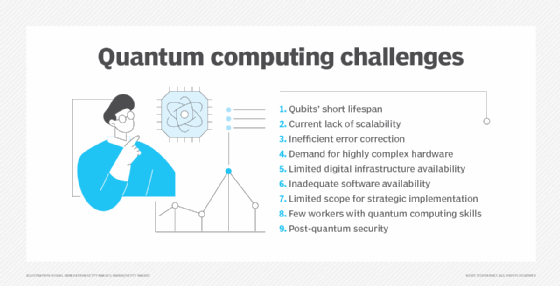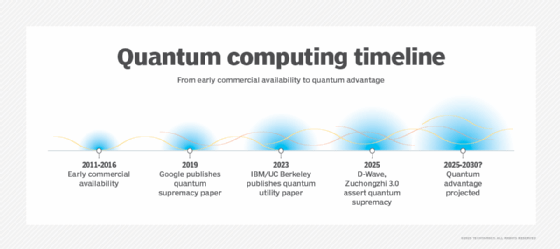What is NISQ computing? Pros and cons
Noisy intermediate-scale quantum (NISQ) computing defines the present stage of quantum computing, in which quantum devices have a moderate qubit count, ranging from 50 to 1,000. The term was coined by physicist John Preskill in 2018 to characterize this prefault-tolerant era of quantum computation.
NISQ computing systems are advanced enough to begin real-world applications across diverse fields. However, these systems are still susceptible to errors stemming from environmental noise and scalability challenges, and they possess limited quantum error correction capabilities.
Characteristics of NISQ computers
NISQ computing is characterized by the following features:
- Qubit count. NISQ devices typically contain tens to a few hundred qubits, with some recent models featuring up to 1,000 qubits. While this scale enables the execution of quantum operations, it's inadequate for large-scale fault-tolerant quantum computing (FTQC) in the future, which requires millions of high-quality qubits.
- Noisy operations. Quantum logic gates and measurements in NISQ systems are susceptible to errors due to environmental noise and hardware imperfections. This leads to unreliable computations.
- Short coherence times. Qubits maintain their quantum states for a short coherence time before decoherence occurs. This limits the depth and complexity of the quantum circuits or computations that can be reliably executed.
- Limited error correction. Unlike FTQC systems, NISQ devices don't have enough high-quality qubits to provide comprehensive quantum error correction (QEC) -- a process that encodes quantum information across multiple physical qubits to detect and correct errors without disturbing the computation. As such, NISQ devices are more prone to computational errors.
- Hybrid computational models. NISQ algorithms frequently use a hybrid approach, integrating quantum processors with classical systems. This addresses challenges in areas such as quantum chemistry simulations, optimization and machine learning (ML), capitalizing on the unique advantages of each.
- Transitional phase. NISQ is a transitional phase in quantum computing. It bridges the gap between current noisy systems and future fault-tolerant quantum computers capable of running more complex algorithms, such as Shor's algorithm.
Benefits of NISQ computers
NISQ computers face issues with noise and their moderate number of qubits. However, they still offer benefits over classical computers, including the following:
- Quantum advantage. NISQ devices, with qubits in the hundreds, can perform tasks beyond the capabilities of classical computers for some problems. This phenomenon is known as quantum advantage.
- Quantum research. The advancement of quantum research relies on NISQ systems, which are essential for exploring quantum algorithms and gaining insights into the behavior of quantum systems. They serve as an important step toward the development of more powerful and fault-tolerant quantum computers.
- Quantum hardware and software. Working with NISQ hardware provides developers and quantum engineers with feedback for improving qubit quality. This reduces noise and develops more efficient quantum control and software tools.
- ML development. Quantum machine learning is a developing field where NISQ devices could offer speed improvements for specific tasks, such as data classification and clustering.
- Hybrid algorithms. The NISQ era has spurred the development of hybrid quantum-classical algorithms, such as variational quantum eigensolver (VQE) and quantum approximate optimization algorithm (QAOA), which strategically divide computational tasks among quantum processors and classical computers, maximizing the use of available quantum resources.
- Real quantum hardware. NISQ computing provides the opportunity to test and refine quantum algorithms on real quantum processors despite their current limitations with noise and errors. Working with real quantum processors, developers can better understand hardware-specific issues, such as qubit coherence times and gate fidelities. These insights are essential for advancing quantum technology.
Limitations and drawbacks of NISQ computers
While NISQ computers represent a step forward in quantum computing, limitations in technologies and investments are keeping quantum computers from reaching their full potential. For example, quantum hardware requires highly specialized infrastructure, including cryogenic systems and precise control mechanisms, which are both complex and costly to develop and maintain.
Also, the absence of standardized quantum software frameworks slows the creation of applications that can operate across different quantum platforms, resulting in a fragmented market. There's also a shortage of skilled professionals with quantum computing expertise, which poses a challenge for advancing the field.
The following are some common challenges of NISQ computers:
- Noise and lack of fault tolerance. NISQ devices are inherently noisy because quantum gates and qubits are prone to errors during computation. As the size of quantum circuits increases, this noise accumulates, limiting the complexity of algorithms that can be reliably executed. Unlike fault-tolerant quantum computers, NISQ systems don't have robust error correction mechanisms. This makes them sensitive to environmental disturbances and operational imperfections.
- Limited qubit and coherence times. NISQ computers typically contain fewer than 1,000 qubits, with many still under 100 qubits. Coupled with short coherence times, which are measured in milliseconds, the complexity and depth of quantum circuits that can be executed reliably are limited.
- Lack of error correction. NISQ devices don't support full quantum error correction due to limited qubit resources. While error mitigation and other techniques exist, they aren't a substitute for true error correction and are often insufficient for large-scale computations.
- Scalability challenges. Hardware limitations and the increased noise that larger systems produce make it difficult to scale up NISQ systems to include more qubits. As a result, it's challenging to build quantum computers capable of solving real-world problems at scale.
- Limited practical applications. Although NISQ devices show quantum advantages for certain tasks, their practical applications are limited. Many of the problems that NISQ systems can solve are highly specialized or not yet relevant to real-world industries. For instance, while NISQ systems can simulate small quantum systems, they aren't advanced enough to simulate larger, more complex systems that would be valuable in applications such as drug discovery and materials science.
- High cost and complexity. Building and maintaining NISQ devices is expensive and requires specialized infrastructure, such as cryogenic systems to keep qubits at near-absolute-zero temperatures. This limits accessibility and widespread adoption.
- High overhead of error mitigation techniques. Error mitigation techniques in NISQ computers reduce the effect of noise. However, they come with their own challenges, such as increased computational overhead on classical computers and limits on the level of noise they can effectively address.
- Uncertain path to quantum advantage. It's still unclear whether NISQ computers can deliver a clear and practical quantum advantage over top classical algorithms for real-world problems. Demonstrations of quantum supremacy have generally involved problems designed to be particularly difficult for classical computers. These problems might not have immediate practical applications.

Use cases of NISQ computers
NISQ computers are being explored for practical applications across various industries. The following are some notable use cases and applications of NISQ computers:
- Quantum chemistry and materials science. Even with their limitations, NISQ computer systems have the potential to simulate molecular structures and chemical reactions. This capability could lead to significant advancements in drug discovery, material science and catalysis. For instance, these systems can model the behavior of complex molecules, which is challenging for classical computers because of the exponential computational resources required for quantum simulations.
- Industry optimizations. Industries such as finance, transportation, logistics and supply chain management can use NISQ devices to solve portfolio optimization, traffic flow management, production scheduling and other optimization problems. For example, in finance, researchers are experimenting with NISQ computers for high-dimensional optimization tasks, such as portfolio optimization.
- Quantum machine learning. Quantum ML algorithms are being developed to process large data sets efficiently, which could enhance predictive analytics and pattern recognition in various fields. For example, in healthcare, quantum ML might be used for analyzing medical data, potentially leading to faster and more accurate diagnoses.
- Cryptography. NISQ computers aren't powerful enough to break current public-key cryptography, such as the Rivest-Shamir-Adleman algorithm. However, they are being used to explore post-quantum cryptography and quantum key distribution for secure communication.
- Scientific research. NISQ systems are being used in academia and industry applications to explore fundamental questions in physics, such as quantum chaos, entanglement and quantum thermodynamics.
- Battery and energy storage. NISQ computing is being applied to simulate the quantum properties of battery materials and electrochemical reactions. Early efforts are focusing on modeling lithium-containing molecules. This method aims to provide atomic-level insights into critical processes, such as ion diffusion. It can potentially speed up the discovery of improved materials for batteries and other energy storage technologies.
Promising algorithms for NISQ computing
NISQ devices are defined by their limited number of qubits and their vulnerability to noise. As a result, they need specialized algorithms that can function effectively within these constraints.
The following are some of the most prominent examples:
- VQE. This algorithm is primarily used to find the ground state energy of molecules in quantum chemistry and materials science. A parameterized quantum state is prepared, and its parameters are optimized using a classical optimizer to minimize an energy expectation value. VQEs require fewer gates compared to other algorithms, making them suitable for NISQ devices.
- QAOA. Aimed at solving combinatorial optimization problems, such as max-cut and traveling salesperson, the QAOA algorithm uses a parameterized quantum circuit to approximate the optimal approach. The QAOA divides large quantum circuits into smaller segments, reducing the number of qubits and gates required, thereby mitigating noise effects.
- Quantum simulation algorithms. Fully accurate simulation of large quantum systems requires fault-tolerant computers. However, NISQ devices are being used to explore small-scale quantum simulations, particularly in condensed matter physics and high-energy physics. They often use variational approaches or Trotterization with error mitigation.
- Quantum ML algorithms. These algorithms integrate quantum computing with ML tasks, potentially offering advantages in data processing and pattern recognition. Various approaches explore quantum circuits, such as feature maps or trainable classifiers. These include variational quantum classifiers and quantum neural networks, where quantum circuits process data and classical optimization techniques are used for training.
History of NISQ computing technology
The NISQ era of quantum computing emerged when it was realized that initial quantum machines were constrained by their limited qubit count and significant noise due to the absence of full error correction.
The NISQ phase followed the theoretical groundwork laid in the 1980s and early experimental quantum algorithm demonstrations on small systems in the late 1990s and early 2000s. A significant milestone occurred in 2019 when Google demonstrated quantum supremacy with its 53-qubit Sycamore processor. This achievement highlighted the potential of NISQ hardware, even as researchers were exploring practical applications for the computers.
By 2024, the largest quantum processors exceeded 1,000 qubits, with Atom Computing's 1,180-qubit processor and IBM's Condor leading the way. Despite these advancements, today's NISQ systems struggle with high error rates and short coherence, hindering their ability to execute complex tasks reliably.
Current research focuses on developing hybrid quantum-classical algorithms and error mitigation techniques to extract useful computations from these noisy devices for applications in various fields.

Future of quantum computing technologies
According to a McKinsey & Company study, four sectors are expected to be the earliest beneficiaries of quantum computing: chemicals, life sciences, finance and mobility. Those sectors could gain up to $2 trillion by 2035.
The future of quantum computing extends beyond the NISQ era, with the ultimate goal being the realization of fault-tolerant quantum computers. This transition will be marked by the ability to perform arbitrarily long and complex computations with low error rates.
The evolution beyond NISQ will involve the following stages and advancements:
- Improved coherence and quality of qubits. Qubits are expected to become more stable with significantly longer coherence times, which will enable deeper and more complex quantum circuits. Error rates for quantum gates will also drastically decrease.
- Development of enhanced quantum error correction. FTQC relies on QEC. Developing scalable and efficient QEC codes is a primary area of research. Although this field is still evolving, researchers are making progress in demonstrating logical qubits with enhanced coherence.
- Increased qubit count. While the number of physical qubits in NISQ devices is in the tens to hundreds, fault-tolerant quantum computers are expected to require millions of physical qubits to encode a smaller number of logical qubits. Recent projections suggest that early fault-tolerant machines with a few hundred logical qubits might appear in the latter half of this decade.
- Topological qubits. Microsoft's Majorana 1 chip takes a unique approach to building more stable qubits using topological conductors. These materials are designed to accommodate quasi-particles known as non-Abelian anyons. The special properties of these anyons could make the resulting qubits inherently more resistant to errors, providing a pathway toward achieving fault-tolerant quantum computers.
- Hybrid architectures. Hybrid computing models, where quantum processors work in tandem with classical high-performance computers, will be developed. Specialized quantum processors tailored for specific classes of problems are also expected to emerge.
The timeline for achieving fully fault-tolerant quantum computing remains uncertain, with estimates ranging from the late 2020s to the 2030s or beyond. Some roadmaps anticipate demonstrating scientific quantum advantage with early FTQCs within the next few years, potentially leading to a commercial tipping point by 2030.
Quantum computing uses the principles of quantum mechanics to solve problems more efficiently than classical computers. Discover potential future applications of quantum computing, including advancements in supply chains, financial modeling, AI optimization and data centers.







